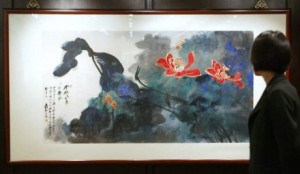The Bubble in the Chinese Art Market
Aug 25th, 2012 | By Ivan Lindsay | Category: Journal It has been rumoured for a few years that the astronomic growth rate attributed to the Chinese art market was exaggerated. Western buyers who tried to participate in auctions on the Chinese mainland said it was difficult and that there was no clarity on what was going on or the final price achieved. Western journalists just repeated the inflated figures provided by the Chinese auction houses as fact. Abigail Esman recently published a well researched expose on the subject in Forbes magazine
It has been rumoured for a few years that the astronomic growth rate attributed to the Chinese art market was exaggerated. Western buyers who tried to participate in auctions on the Chinese mainland said it was difficult and that there was no clarity on what was going on or the final price achieved. Western journalists just repeated the inflated figures provided by the Chinese auction houses as fact. Abigail Esman recently published a well researched expose on the subject in Forbes magazine
http://www.forbes.com/sites/abigailesman/2012/08/13/chinas-13-billion-art-fraud-and-what-it-means-for-you/
“The Fragrance of Lotus after Rain” by Zhang Daqian(above).
Armen Apresyan recently published a follow up piece in The Voice of Russia
The Bubble of the Chinese Art Market – Zhang Daqian v Pable Picasso
Aug 22, 2012 15:51 Moscow time
Over the last few years the center of the world art market has been moving away from Europe and America to China. At least that is what the leading trade magazines are saying. According to a number of art market analysts, in 2011 the Chinese market of antiques and modern art showed the greatest growth rate of over 20%.
Early this year the professional art community already voiced the idea that this growth cannot continue forever and is bound to slow down. Today those forecasts are coming true. Unlike last year, when the world’s mass media reported a new sales record on Chinese art objects on a monthly basis, 2012 has been not that fruitful in notable deals. Moreover, art market participants increasingly talk about the fact that all the positive trends of the past related to China has been nothing more than a “bubble”.
In March 2012 in her speech presented in Maastricht at the European Fine Art Fair (TEFAF), which is the largest and most respected art fair in the world, art economist Clare McAndrew stated that the majority of deals made at Chinese art auctions are never paid for. It is noteworthy that the data from the sales at such art auctions are used as the basis for various ratings. “It is one thing to announce a multimillion dollar deal, and quite a different matter to actually close it,” she pointed out, “The buyers do not pay, and thus, China is not the leader of the art market.”
Doubtful is not only the general situation on the Chinese art market, but also the unbelievable growth of the prices for the works of such artists as Zhang Daqian. The 2011 sales volume of his works amounted to $506.7 million, which became an absolute record. As the Voice of Russia already reported, Zhang Daqian even shifted aside Pablo Picasso, who was previously the most popular artist that ranked at the top since 1997. Unlike Pablo Picasso, whose name is familiar to everybody, the name of Zhang Daqian’s name was recently not widely known to most art lovers. Thus, such interest towards his works is considered by most art enthusiasts to be quite unnatural.
In an article recently published by Forbes, Abigail R. Esman makes a statement not only about the false nature of the Chinese art market, but also makes her own investigation. In her opinion, the Chinese government is the prime beneficiary of the art market “bubble”.
Her conversations with Chinese art dealers led her to those conclusions. Based on the information that she received talking to the art dealers in China, Esman writes that the country’s largest art auction house in Beijing – Poly Auctions – is a part of the Poly company, which in turn is related to Poly Technologies, the main arms producer for the Chinese Army.
Thus, according to Esman, with the help of a defense industry producer tied to the Chinese army, the government creates an image of a prosperous Chinese economy, which in theory should attract foreign investors.
On the Poly example, she describes a scheme frequently used by Chinese auction houses: the owner of a painting becomes its “buyer”. Such a “buyer” only pays a small commission to the auction house, but most importantly gets the sales statistics that helps him inflate the prices for similar works. As a result, art prices are artificially inflated. As a result, today one cannot be sure if an ancient vase can really cost millions of dollars, or if the price has been artificially hiked up.
Representatives of Poly Auctions refuse to confirm or even comment on such assumptions. This appears to be quite unreasonable, as Forbes is a respected periodical and people listen to the opinions of its authors. It would be worthwhile to at least try to dissuade its readers, or offer another credible version of what is going on in the Chinese art market.

Thank you for quoting my piece here! I must correct you, however; Poly did not refuse to comment at all. If you read my article at Forbes you will see that they categorically denied everything, despite the fact that several people had already confirmed it.